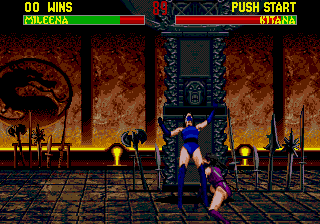Retro Replay Review
Gameplay
Mortal Kombat II refines the one-on-one fighting formula introduced in its predecessor, delivering a tighter control scheme and deeper combat mechanics. Players engage in best-of-three-round matches that emphasize timing, positioning, and strategic use of special moves. The addition of new characters with distinct move sets encourages experimentation, as each fighter brings unique strengths—whether it’s Scorpion’s spear pull, Sub-Zero’s ice freeze, or Mileena’s rapid sai barrages.
(HEY YOU!! We hope you enjoy! We try not to run ads. So basically, this is a very expensive hobby running this site. Please consider joining us for updates, forums, and more. Network w/ us to make some cash or friends while retro gaming, and you can win some free retro games for posting. Okay, carry on 👍)
Beyond basic punches, kicks, and blocks, the game rewards mastery of special commands. Executing fireballs, teleportations, and multi-hit combos adds layers to encounters, transforming matches from button-mashing melees into tactical duels. Throws, sweeps, and aerial attacks help balance the engine; no two characters play exactly alike, and learning each roster member’s nuances can turn the tide even against a skilled adversary. The precision required for these inputs gives victories a real sense of accomplishment.
What truly sets Mortal Kombat II apart is its expanded Fatality system. Rather than a single finishing move per fighter, each character now boasts multiple gruesome finishers, as well as hidden “Babalities” and “Friendships” in certain versions. These over-the-top end sequences not only underscore the game’s signature gore but also add replay value, as you’ll find yourself striving to discover and execute every variation—whether you’re sending opponents into acid pits or offering them a celebratory balloon animal.
Graphics
For its arcade-era origins, Mortal Kombat II sports impressively detailed digitized sprites and richly painted backgrounds. Characters appear more refined than in the original title, with smoother animations and greater visual diversity between fighters. The environments—from the fog-shrouded temple to the lava-lit throne room—are rendered with evocative color palettes that heighten the otherworldly atmosphere of Outworld’s arenas.
Blood and gore remain a hallmark, and on uncensored arcade cabinets the crimson splatters feel both shocking and patently cartoonish—an intentional contrast that underlines the game’s stylized brutality. Later home conversions on systems like the Sega Genesis and Super Nintendo sometimes toned down these effects, resulting in a less visceral experience. However, the core art and animation quality remain strong across platforms, ensuring that even handheld or 16-bit iterations retain the franchise’s distinctive look.
Stage-specific Fatalities further showcase environmental detail, allowing players to interact with backgrounds in creative ways—spiking foes on wall-mounted blades or dumping them into murky water pits. This level of interactivity feels ahead of its time and enriches the presentation. Whether you’re marvelling at a flawless combo or admiring the gory aftermath, Mortal Kombat II’s graphical prowess holds up as a standout example of mid-’90s arcade craftsmanship.
Story
The narrative picks up directly after the events of the first Mortal Kombat tournament, with Shang Tsung’s defeat paving the way for Emperor Shao Kahn’s devious plans. Shao Kahn lures Earthrealm’s greatest fighters back to Outworld under false pretenses, concealing his true intention: the complete subjugation of Earth. This continuation of the original plot gives returning players a rewarding sense of continuity and raises the stakes with a more sinister villain behind the scenes.
Each character’s personal motivations are lightly sketched but effective: Liu Kang fights to protect his homeland, Kitana seeks justice for her enslaved people, and newcomers like Jax avenge fallen comrades. These backstories play out through brief but memorable pre-match dialogues and end-of-line quips, giving every bout a loose narrative context. Although the story isn’t delivered through lengthy cutscenes, the pacing suits the arcade format and keeps the action front and center.
The climactic boss gauntlet—first against Shang Tsung (who can morph into other fighters), then the monstrous Kintaro, and finally Shao Kahn himself—serves as a thrilling narrative crescendo. Each boss encounter tests your command of mechanics while reinforcing the feeling that you’re battling ever-greater threats. By the time the credits roll, you’ve earned more than just bragging rights; you’ve thwarted an interdimensional invasion and cemented your place as Outworld’s ultimate champion.
Overall Experience
Mortal Kombat II stands as one of the era’s defining fighting games, blending fast-paced duels, a memorable roster, and jaw-dropping finishers into an addictive package. Whether you’re tackling the arcade ladder in single-player mode or challenging a friend in head-to-head combat, the core loop remains endlessly engaging. The challenge curve is steep but fair, rewarding players who invest time in learning character matchups and execution techniques.
Replay value is bolstered by the diversity of fighters and the multitude of Fatalities to unlock. Casual players can enjoy button-bashing mayhem, while hardcore enthusiasts will pore over frame data and combo strings to eke out every pixel of advantage. The multiplayer component—once you find someone brave enough to take you on—ushers in some of the most electrifying competitive moments of the 16-bit generation.
In terms of legacy, Mortal Kombat II not only expanded on what made the original great but also set a new standard for the fighting genre. Its combination of refined gameplay mechanics, striking visuals, and unforgettable gore sequences ensures it remains a must-play title for fans of arcade classics. If you’re seeking a game that’s equal parts brutality and strategic depth, this sequel delivers in spades and still holds up as a thrilling experience today.
 Retro Replay Retro Replay gaming reviews, news, emulation, geek stuff and more!
Retro Replay Retro Replay gaming reviews, news, emulation, geek stuff and more!









Reviews
There are no reviews yet.